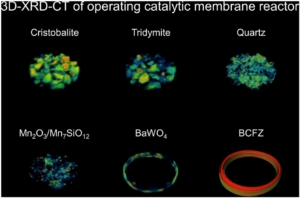Our latest work on X-ray tomographic diffraction imaging of operating dense ceramic hollow-fibre catalytic membrane reactors (CMRs)
You can see our latest work on X-ray tomographic diffraction imaging of operating dense ceramic hollow-fibre catalytic membrane reactors (CMRs) – “Real-time tomographic diffraction imaging of catalytic membrane reactors for the oxidative coupling of methane” in Catalysis Today. The paper is a result of a collaboration between scientists at UCL Chemistry, Finden, ESRF, VITO and ISIS Neutron and Muon Source.
 Highlights include:
Highlights include:
- Synchrotron X-ray diffraction computed tomography applied to three packed bed catalytic membrane reactors.
- The solid-state evolution of catalysts and membranes is tracked under operating conditions.
- A new crystal structure model of BaCo0.4Fe0.4Zr0.2O3-δ (BCFZ) is suggested and used for the diffraction data analysis
Catalytic membrane reactors have the potential to render the process of oxidative coupling of methane economically viable. Here, the results from operando XRD-CT studies of three different catalytic membrane reactors, employing BaCo0.4Fe0.4Zr0.2O3-δ (BCFZ) and La0.6Sr0.4Co0.2Fe0.8O3-δ (LSCF) perovskite membranes with Mn-Na-W/SiO2 and La-promoted Mn-Na-W/SiO2 catalysts, are presented. It is shown that synchrotron X-ray tomographic diffraction imaging allows the extraction of spatially-resolved diffraction information from the interior of these working catalytic membrane reactors and makes it possible to capture the evolving solid-state chemistry of their components under various operating conditions (i.e. temperature and chemical environment).
Read the paper at https://doi.org/10.1016/j.cattod.2020.05.045
